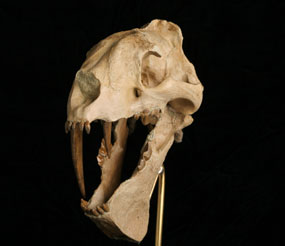 |
| Saber tooth nimravids, like this eusmilus, filled the Cat niche 30 million years ago. |
 |
The paleontology division at John Day Fossil Beds manages fossil animal and plant fossils, and ancient soil and rock samples from geological formations that span over 40 Ma during the Age of the Mammals.
The research and fossil management encompass four major areas: Basic research and basinwide investigative coordination, paleobotany, museum curation, and fossil preparation. Research areas include paleontology, statigraphy, radiometric dating, paleomagnetic coorelation, paleopedological (fossil soil) analysis, paleogeochemistry, biostratigraphy, and paleobiology.
Researchers from around the world are currently working on these topics within the John Day Fossil Beds under the coordination of park paleontology staff. The paleobotanical (fossil plants) resources of eastern Oregon are some of the most prolific and diverse to be found anywhere.
Because plants are generally better environmental indicators than fossil animals, the John Day paleontology staff also works to identify the plant types over time and thereby reconstruct the ancient ecosystems and climates of eastern Oregon.Two of the many floras included within the John Day Fossil Beds include the Clarno Nut Beds and the Bridge Creek Floras.
Paleontological preparation of fossil vertebrates occurs at the monument. Following the discovery of a rare specimen and prior to detailed research, a fossil must undergo rigorous preparation and conservation. Rock and matrix must be removed and consolidants and glues must be used to preserve fossil specimens for study and exhibition. This requires the specialized skills that include detailed knowledge of anatomy and zoology, an understanding of chemistry, and the steady hands and patience of an artisan.
Fossil specimens and geological samples that are collected in the John Day Basin are curated at the park museum where National Park Service conservation and museum management procedures ensure that the specimens will be preserved and protected for both current and future research and education.
| 





